String tied to Neanderthal yarn
 The discovery of the oldest known piece of string shows Neanderthals were even more advanced than once believed.
The discovery of the oldest known piece of string shows Neanderthals were even more advanced than once believed.
The discovery of the oldest known direct evidence of fibre technology — using natural fibres to create yarn — has been reported in Scientific Reports, made by Neanderthals during the Middle Palaeolithic period (30,000–300,000 years ago).
Researchers discovered a six-millimetre-long cord fragment consisting of three bundles of fibres twisted together and adhering to a 60-millimetre-long, thin stone tool.
They speculate that the cord was wrapped around the tool as a handle or was part of a net or bag containing the tool.
They dated the cord fragment, which was discovered in Abri du Maras, France, to between 41,000–52,000 years ago.
Using spectroscopy and microscopy, they identified that the cord likely consists of fibres taken from the inner bark of a non-flowering tree such as a conifer.
The authors suggest that production of the cord would have required extensive knowledge of the growth and seasonality of the trees used.
They also speculate that Neanderthals may have needed an understanding of mathematical concepts and basic numeracy skills to create bundles of fibres (yarn), the three-ply cord and rope from multiple cords.
Prior to this discovery the oldest discovered fibre fragments were from the Ohalo II site in Israel, dating back to around 19,000 years ago.
The findings of the new study suggest that fibre technology is much older, and that the cognitive abilities of Neanderthals may have been more similar to those of modern humans than previously thought.








 Print
Print